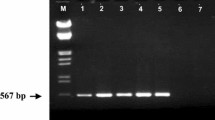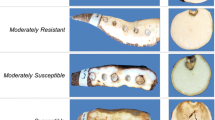Abstract
Between 580 and 700 accessions of related cultivated and wild species of the genus Beta were assessed for resistance to four soil-borne diseases of sugar beet: two seedling damping-off diseases caused by the fungi Aphanomyces cochlioides and Pythium ultimum and two diseases of more mature plants, Rhizoctonia root and crown rot, caused by the fungus R. solani, and Rhizomania, caused by Beet necrotic yellow vein virus (BNYVV), a furovirus transmitted by the plasmodiophorid Polymyxa betae. Analysis of resistance data (assessed on an international standardised 1–9 scale of Resistance Scores) indicated that the highest levels of resistance ({RS}≤ 2) to A. cochlioides and P. ultimum were to be found amongst accessions of the more distantly related sections Corollinae (93% of accessions tested) and Procumbentes (10%), respectively; although useful levels could also be found in the more closely related, and sexually compatible, section Beta (1–6%). Resistance to Rhizoctonia was also found in section Beta (5–7%), depending on whether field or glasshouse tests were used, but there was little evidence of generally high levels of resistance to Rhizomania among accessions of this section. None of the accessions of sections Corollinae and Procumbentes exhibited any notable resistance to Rhizoctonia. However, all sections Procumbentes and some sections Corollinae (4%) accessions were highly resistant to Rhizomania. Individuals with high levels of resistance to Rhizomania were identified from within some section Beta and Corollinae accessions, in which there was evidence of segregation.
Similar content being viewed by others
References
Asher, M.J.C., 1993. Rhizomania. In: D.A. Cooke & R.K. Scott (Eds.), The Sugar Beet Crop, pp 311–346. Chapman & Hall, London.
Asher, M.J.C. & A.M. Dewar, 1994. Control of pests and diseases in sugar beet by seed treatments. In: T. Martin (Ed.), Seed Treatment: Progress and Prospects, pp 151–158. BCPC monograph 57. BCPC publications, UK.
Ayala-Garcia, J., G. Büttner, H. Gutiérez, W. Heijbroek, P. Ioannides, M. Nihlgaard, M. Richard-Molard, L. Panella, V. Rossi, H. Rössner, J.H.M. Schneider & A. Wauters, 2001. Integrated control of Rhizoctonia root rot – First results of an I.I.R.B. trial series. In: Proceedings of the 64th Congress of the Institut International de Recherches Betteravières, pp 397–400. IIRB, Brussels.
Barr, K.J., M.J.C. Asher & B.G. Lewis, 1995. Resistance to Polymyxa betae in wild Beta species. Plant Pathol 44: 301–307.
Biancardi, E., R.T. Lewellen, M. De Biaggi, A.W. Erichsen & P. Stevanato, 2002. The origin of Rhizomania resistance in sugar beet. Euphytica 127: 383–397.
Boerema, G.H. & A.A. Verhoeven, 1976. Check-list for scientific names of common parasitic fungi. Series 2a. Fungi of field crops: Beet potatoes, caraway, flax and oilseed poppy. Neth J Plant Pathol 82: 193–214.
Bosemark, N.O., 1993. Genetics and breeding. In: D.A. Cooke & R.K. Scott (Eds.), The Sugar Beet Crop, pp 66–119. Chapman & Hall, London.
Buttler, K.P., 1977. Variation in wild populations of annual Beta (Chenopodiaceae). Plant Syst Evol 128: 123–136.
Cai, D., M. Kleine, S. Kifle, H.-J. Harloff, N.N. Sandel, K.A. Marcker, R.M. Klein-Lankhorst, E.M.J. Salentijn, W. Lange, W.J. Stiekema, U. Wyss, F.M.W. Grundler & C. Jung, 1997. Positional cloning of a gene for nematode resistance in sugar beet. Science 275: 832–834.
Dunning, R.A. & W. Heijbroek, 1981. Improved plant establishment through better control of pest and disease damage. In: Proceedings of the 44th Congress of the Institut International de Recherches Betteravières, pp 37–59. IIRB, Brussels.
Duffus, J.E. & E.G. Ruppel, 1993. Diseases. In: D.A. Cooke & R.K. Scott (Eds.), The Sugar Beet Crop, pp 346–427. Chapman & Hall, London.
Frese, L., B. Desprez, & D. Ziegler, 2001. Potential of genetic resources and breeding strategies for base-broadening in Beta. In: H.D. Cooper, C. Spillane & T. Hodgkin (Eds.), Broadening the Genetic Base of Crop Production, pp 295–309. IPGRI/FAO, Rome.
Fujisawa, I. & T. Sugimoto, 1979. The reaction of some beet species of the sections Patellares, Corollinae and Vulgares to Rhizomania of sugar beet. Proc Sugar Beet Res Assoc Jpn 21: 31–38.
Gaskill, J.O., 1968. Breeding for Rhizoctonia resistance in sugar beet. J Am Soc Sugar Beet Technol 15: 107–119.
Hall, G., 1989. Aphanomyces cochlioides. CMI Descriptions of pathogenic fungi and bacteria, No. 972. Mycopathology 106: 185–186.
Hecker, R.J. & E.G. Ruppel 1977. Rhizoctonia root-rot resistance in sugar beet: Breeding and related research. J Am Soc Sugar Beet Technol 19: 246–256.
Heijbroek, W., P.M.S. Musters & A.H.L. Schoone, 1999. Variation in pathogenicity and multiplication of beet necrotic vein virus (BNYVV) in relation to resistance of sugar-beet cultivars. Eur J Plant Pathol 105: 397–405.
IDBB, 2003. International Database for Beta (IDBB). Website: http://www.genres.de/idb/beta
Koenig, R., P. Ludigr ddecke & A.M. Haeberle, 1995. Genome differences between beet necrotic yellow vein virus (BNYVV) sources from different parts of the world. In: Proceedings of the 58th Congress of the Institut International de Recherches Betteravières, pp 271–278. IIRB, Brussels.
Lange, W., W.A. Brandenburg & Th.S.M. De Bock, 1999. Taxonomy and cultonomy of beet (Beta vulgaris L.). Bot J Linn Soc 130: 81–96.
Leach, L.D., 1986. Seedling diseases. In E.D. Whitney & J.E. Duffus (Eds.) Compendium of Beet Diseases and Insects, pp 5–8. American Phytopathological Society, St. Paul, Minnesota.
Lewellen, R.T. & E.D. Whitney, 1993. Registration of germplasm lines developed from composite crosses of sugar beet × Beta maritima. Crop Sci 33: 882–883.
Lewellen, R.T., I.O. Skoyen & A.W. Erichsen, 1987. Breeding sugar beet for resistance to Rhizomania: Evaluation of host-plant reactions and selection for, and inheritance of, resistance. In: Proceedings of the 50th Congress of the Institut International de Recherches Betteravières, pp 139–156. IIRB, Brussels.
Luterbacher, M.C., M.J.C. Asher, E. DeAmbrogio, E. Biancardi, P. Stevenato & L. Frese, 2004. Sources of resistance to of sugar beet in related Beta germplasm: I. Foliar diseases. 139: 105–121.
Mesbah, M., O.E. Scholten, Th.S.M. De Bock & W. Lange, 1997. Chromosome localisation of genes for resistance to Heterodera schachtii, Cercospora beticola and Polymyxa betae using sets of Beta procumbens and B. patellaris derived monosomic additions in B. vulgaris. Euphytica 97: 117–127.
O’Sullivan, E. & J.A. Kavanagh, 1992. Characteristics and pathogenicity of Pythium spp. associated with damping-off of sugar beet in Ireland. Plant Pathol 41: 582–590.
Panella, L., 1998. Screening and utilizing Beta genetic resources with resistance to Rhizoctonia root rot and Cercospora leaf spot in a sugar beet breeding programme. In: L. Frese, L. Panella, H.M Srivastava & W. Lange (Eds.), Report of the 4th International Beta Genetic Resources Workshop & World Beta Network Conference, Izmir, Turkey. IPGRI, Rome.
Papavizas, G.C. & W.A. Ayers, 1974. Aphanomyces species and their root diseases in pea and sugar beet – A review. USDA Technical Bulletin 1845. Washington, DC.
Paul, H., B. Henken & M.F.J. Alderlieste, 1992a. A greenhouse test for screening sugar-beet (Beta vulgaris) for resistance to beet necrotic yellow vein virus (BNYVV). Neth J Plant Pathol 98: 65–75.
Paul, H., B. Henken, Th.S.M. De Bock & W. Lange, 1992b. Resistance to Polymyxa betae in Beta species of the section Procumbentes, in hybrids with B. vulgaris and in monosomic chromosome additions of B. procumbens in B. vulgaris. Plant Breed 109: 265–273.
Paul, H., B. Henken, O.E. Scholten, Th.S.M. De Bock & W. Lange, 1993a. Variation in the level of infection with Polymyxa betae and its effect on infection by beet necrotic vein virus in beet accessions of the section Beta and Corollinae. In: Proceedings of the Second Symposium of the International Working Group on Plant Viruses with Fungal Vectors, pp. 133–136. Montreal, Canada.
Paul, H., B. Henken, O.E. Scholten & W. Lange, 1993b. Use of zoospores of Polymyxa betae in screening beet seedlings for resistance to beet necrotic vein virus. Neth J Plant Pathol 99 (3 Suppl): 151–160.
Paul, H., F.A. Van Eeuwijk & W. Heijbroek, 1993c. Multiplicative models for cultivar by location interaction in testing sugar beets for resistance to beet necrotic yellow vein virus. Euphytica 71: 63–74.
Payne, P.A., M.J.C. Asher & C.D. Kershaw, 1994. The incidence of Pythium spp. and Aphanomyces cochlioides associated with the sugar beet growing regions of Britain. Plant Pathol 43: 300–308.
Schneider, C.L. & G.J. Hogaboam, 1983. Evaluation of sugarbeet breeding lines in greenhouse tests for resistance to Aphanomyces cochlioides. J Am Soc Sugar Beet Technol 22: 101–107.
Schneider, C.L. & E.D. Whitney, 1986. Rhizoctonia root and crown rot. In: E.D. Whitney & J.E. Duffus (Eds.), Compendium of Beet Diseases and Insects, p. 21. American Phytopathological Society, St. Pauls, Minnesota.
Scholten, O.E. & W. Lange, 2000. Breeding for resistance to Rhizomania in sugar beet: A review. Euphytica 112: 219–231.
Van Geyt, J.P.C., W. Lange, M. Oleo & T.S.M. De Bock, 1990. Natural variation within the genus Beta and its possible use for breeding sugar beet: A review. Euphytica 49: 57–76.
Walker, R., 2002. Development of bacterial seed treatments for the control of Aphanomyces cochlioides on sugar beet. Ph.D Thesis, University of Nottingham, UK.
Whitney, E.D., 1989. Identification, distribution, and testing for resistance to Rhizomania in Beta maritima. Plant Dis 73: 287–290.
Williams, G.E. & M.J.C. Asher, 1996. Selection of rhizobacteria for the control of Pythium ultimum and Aphanomyces cochioides on sugar-beet seedlings. Crop Prot 15: 479–486.
Author information
Authors and Affiliations
Corresponding author
Rights and permissions
About this article
Cite this article
Luterbacher, M.C., Asher, M.J.C., Beyer, W. et al. Sources of resistance to diseases of sugar beet in related Beta germplasm: II. Soil-borne diseases. Euphytica 141, 49–63 (2005). https://doi.org/10.1007/s10681-005-5231-y
Received:
Accepted:
Issue Date:
DOI: https://doi.org/10.1007/s10681-005-5231-y




